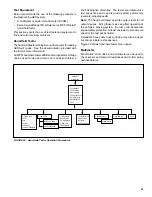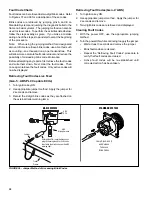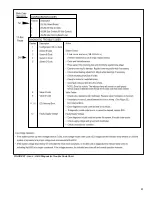
38
ABS — Antilock Brake System. A control system that maintains
wheel slip at a level that minimizes stopping distance while
maintaining lateral stability to the extent possible.
Air Gap — Distance between the sensor pole piece and tone
ring.
Anti-Compounding — A method to prevent the application of
the service brakes and spring brakes at the same time to prevent
excessive stress on brake components.
Apply Timing — The time from the first movement of the service
brake control for the brake chamber to reach 60 PSI beginning
with an initial service reservoir pressure of 100 PSI.
Channel — A controlled wheel site.
CAN — Controller Area Network.
Clear Codes — Method for erasing historical faults from the ECU,
using either the diagnostic switch input or a hand-held diagnostic
tool. (Only repaired faults may be cleared).
Coefficient of Friction: — The horizontal force required to move
a body (on a relatively smooth level surface) divided by the weight
of the body.
Configuration — Process of identifying a “normal” set of sensors
and modulators for the Electronic Control Unit, so that it can
identify future missing sensors and modulators.
Crack Pressure — The ascending input pressure or input force
to an air valve required to initiate output pressure of flow.
Diagnostic Connector — Deutsch HD-10 Series connector used
for interface to hand-held testers or PC based diagnostic
equipment based on the J1587 protocol. The tester can initiate
test sequences, and can also read system parameters.
Directly Controlled Wheel — A wheel that is sensed to be
slipping, and is adjusted to correct for that slip.
ECU — Electronic Control Unit.
FMVSS-121 — Federal Motor Vehicle Safety Standard that
regulates air brake systems.
Friction Sleeve — A beryllium copper sleeve which has fingers
cut into it. It is pressed between an ABS sensor and mounting
hole to hold the sensor in place.
Full-Treadle Brake Application — A brake application in which
the treadle valve pressure in any of the valve’s output circuits
reaches 100 psi within 0.2 seconds after the application is
initiated.
Independently Controlled Wheel — Directly controlled wheel
for which the modulator does not adjust the brake actuating forces
for any other wheel on the axle.
Indirectly Controlled Wheel — A wheel whose braking is
adjusted in response to wheel speed information from an adjacent
wheel.
IR — Independent Regulation. A control method in which a
wheel is controlled at optimum slip, a point where retardation
and stability are maximized. The brake pressure that is best for
the wheel in question is directed individually into each brake
chamber.
MIR — Modified Independent Regulation. A method of controlling
the opposite sides of a steer axle during ABS operation so that
torque steer and stopping distance are minimized. Usually control
begins at pure select low and moves towards independent control
as the cycle progresses.
Peak Friction Coefficient (PFC) — The ratio of the maximum
value of braking test wheel longitudinal force to the simultaneous
vertical force occurring prior to wheel lockup, as the braking torque
is progressively increased.
QR — Quick Release. Quick release valves allow faster release
of air from the brake chamber after a brake application. To
balance the system, quick release valves may have hold off
springs that produce higher crack pressures (when the valves
open).
Relay Valve — A pneumatic amplifier. A relay valve provides
large quantities of air from supply reservoirs located nearby in
response to a low flow control signal originating from a remote
source. Relay valves have an associated crack pressure. No
pressure is delivered until the control pressure reaches the crack
pressure.
Release Timing — The time from initial brake pedal movement
(release), for a set of brake chambers initially at 95 PSI to reach
5 PSI.
Select High — An ABS control strategy in which several sensed
wheels are controlled by a single valve. The pressure at both
wheels is controlled by the wheel that has the least tendency
towards locking.
Select Low — An ABS control strategy in which several sensed
wheels are controlled by a single valve. The pressure at both
wheels is controlled by the wheel that has the greatest tendency
towards locking.
Select Smart — An ABS control strategy in which several sensed
wheels are controlled by a single valve. If the wheels are
determined to be on significantly different surfaces (e.g. ice on
one side and asphalt on the other) select high operation is chosen.
If the surfaces are close to homogeneous a select low strategy
is chosen.
Sensor Bushing — A bushing which is pressed into axles to
hold a wheel speed sensor and friction sleeve.
Stored Faults — A fault that occurred.
Tone Ring — A ring that is usually pressed into a wheel hub that
has a series of teeth (usually 100) and provides actuation for the
speed sensor. Note maximum run out is .008 TIR.
Warning Light — An amber light which indicates the operating
status of an antilock system. When the warning lamp is on, ABS
is disabled and the vehicle reverts to normal brake operation.
Glossary



































